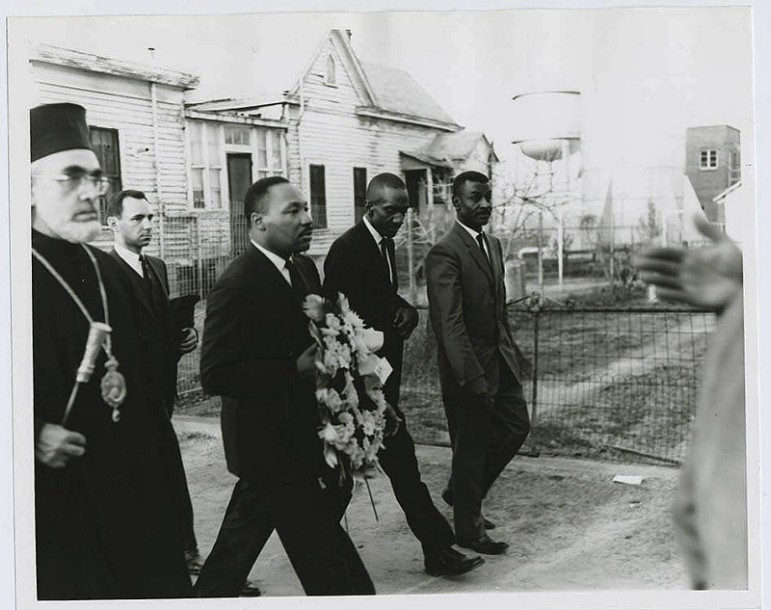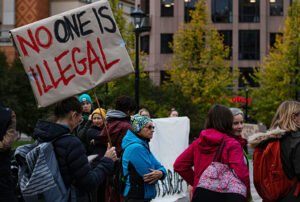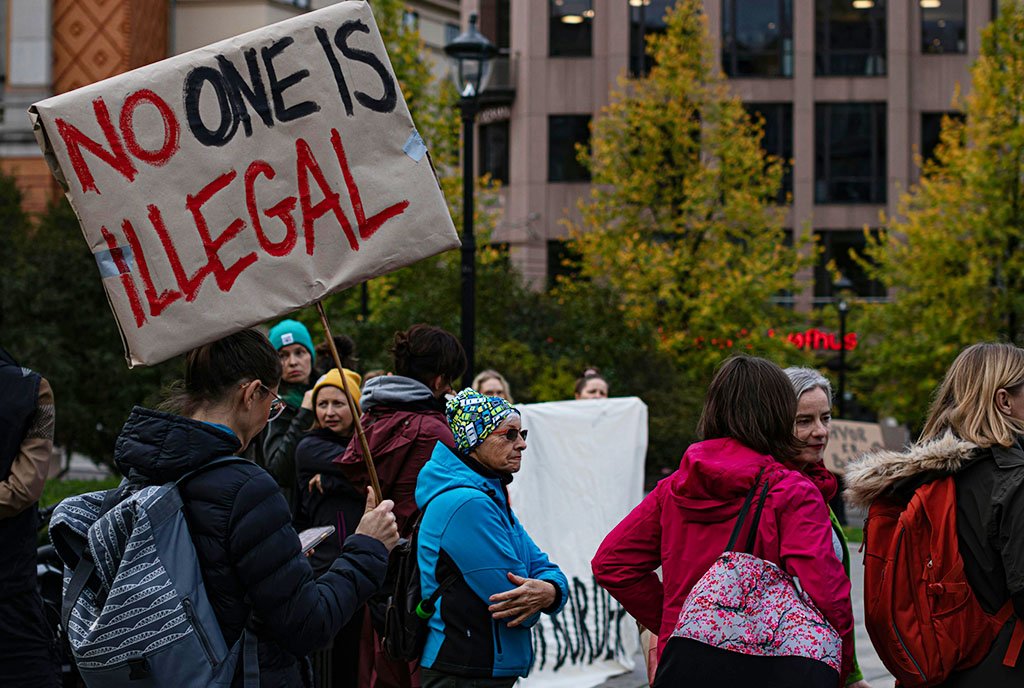
April 23, 2016; New York Times, Toronto Star, and Washington Post
Black Lives Matter (BLM) began in 2014 as a hashtag after the acquittal of George Zimmerman in the Trayvon Martin case and evolved into a social movement. Since its inception, it has grown to 28 chapters in over 17 states and one international chapter in Toronto. There’s no denying that the movement wants to disrupt the status quo, and that will make some people angry. They have shut airports and stopped Black Friday sales with their protests against police brutality. They have interrupted several events on the current campaign trail. They interrupted Hillary Clinton in February at a campaign event, and even shut down a Bernie Sanders event last year with their protests. And everyone has seen the violence that has erupted at Donald Trump events where Black Lives Matters protestors clashed with Trump supporters. They are described by some political candidates as a “mob,” “trouble,” and “disgraceful.”
Even President Obama has spoken out about the group’s tactics. During a speech during his recent visit to London, the New York Times reported that President Obama said, speaking in reference to BLM “Once you’ve highlighted an issue and brought it to people’s attention and shined a spotlight, and elected officials or people who are in a position to start bringing about change are ready to sit down with you, then you can’t just keep on yelling at them.” We find this statement alarmingly uninformed as far as social change dynamics are concerned and, we have to ask, is the discord around this current social movement any different from what protestors in the South experienced during the Civil Rights era?
What’s interesting is that much of the language used today to describe the Black Lives Matter movement is the same used to describe people participating in the Civil Rights movement of the 1960s. It seems, too, that overall public sentiment about the social movement is eerily similar. When polled, many Americans in the 1960s felt the protests did not reflect positively upon the Civil Rights movements. Surveys compiled by the Roper Center for Public Opinion Research at Cornell University give us a glimpse of the nation’s mood throughout the decade. When polled, 61 percent of Americans disapproved of what the Freedom Riders were doing. Fifty-seven percent of respondents thought that sit-ins at lunch counters, “freedom buses,” and other demonstrations would hurt African Americans’ chances for true integration. One of the most famous marches in history, the March on Washington, found disfavor with 60 percent of people polled.
When broken down by race, there was an even wider divide. According to the Washington Post, in 1965, two years after the March on Washington, 94 percent of African Americans rated the job Martin Luther King Jr. “has done in the fight for Negro rights” as positive, according to a Harris survey. But when the polling company asked white adults the next year whether King was helping or hurting the cause, just 36 percent said he was helping; half of whites said he was hurting, while 14 percent said they weren’t sure. The divide was bigger still when asking whites about demonstrations overall: 85 percent of whites in a 1966 Harris survey said such protest actions by blacks would hurt the advancement of civil rights. However, for blacks, 70 percent said activities such as sit-ins, store picketing, and demonstrations helped the effort to win equal rights, according to a 1969 survey conducted by Newsweek.
The poll results from the Civil Rights era seem surprising from our present-day vantage point. Dr. King has a nationally recognized federal holiday, and children are taught about the Civil Rights movement in schools, its leaders held high as heroes who sacrificed their freedom and safety for the cause. But activists experienced something very different in the moments of the movement. Kathleen Weldon of the Roper Center says that people in the 1960s were “very uncomfortable with protest, and especially regarding the potential for violence. They weren’t particularly convinced that it was helpful.” Many Civil Rights leaders are surprised to be held in such high esteem today. Joyce Ladner, who was deeply involved with the Student Non-Violent Coordinating Committee’s (SNCC) organizing in Mississippi, told the Washington Post, “When I’m told by people, ‘Thank you for what you did,’ I almost want to look around and see who they’re talking to.”
And now, fifty years later, racial lines similarly divide opinions about BLM. A poll conducted by PBS/Marist from September 2015 found that only 25 percent of whites felt the Black Lives Matter movement focused on real issues of racial discrimination, while 65 percent of blacks believed that it did. So how does the feeling about civil rights activists change from negative to positive? Time, says Weldon:
It’s a very clear picture—and not necessarily the picture we like to lay back on time that we see from today; it’s not necessarily the story we tell ourselves. Time passes and people can start to intentionally or not rewrite history, particularly around something that seems as amorphous as public opinion—what everyone believed, what everyone thought.
Sign up for our free newsletters
Subscribe to NPQ's newsletters to have our top stories delivered directly to your inbox.
By signing up, you agree to our privacy policy and terms of use, and to receive messages from NPQ and our partners.
“The very nature of protest is fighting against the norm,” says Charles Cobb, who was a field secretary for the SNCC in the 1960s. “Whether it’s segregated lunch counters or voting rights or whether it’s police violence—that’s what protest does, and it challenges with varying degrees of intensity the status quo,” Cobb told the Washington Post. He went on to say that recognizing the deep opposition toward the Civil Rights movement’s tactics in its day—“the things we think of normal today and not controversial”—may cause people to “think through what their opinions are about things today, and why they have those opinions.”
But while Cobb appreciates the similarities, many Civil Rights leaders do not like the group’s tactics. Barbara Reynolds, who was involved in the civil rights movement in the 1960s, wrote in an article in the Washington Post:
The baby boomers who drove the success of the civil rights movement want to get behind Black Lives Matter, but the group’s confrontational and divisive tactics make it difficult. In the 1960s, activists confronted white mobs and police with dignity and decorum, sometimes dressing in church clothes and kneeling in prayer during protests to make a clear distinction between who was evil and who was good.
But the Black Lives Movement is not based in the same spirituality. It was not started in church basements and preached from church pulpits. The movement is reflective of today’s cultural climate and society’s evolution from the ’60s overall. Pamela Lightsey, a noted theologian and lecturer on queer theology at Boston University’s Theological Seminary who chronicled the Ferguson protests, told the Washington Post, “BLM rejects the usual hierarchical style of leadership, with the straight black male at the top giving orders. BLM also gives special attention to the needs of black queers, the black transgendered, the black undocumented, black incarcerated and others who are hardly a speck on today’s political agenda.”
Regardless of the differing opinions, Black Lives Matter has had its successes with inflecting change, just as the Civil Rights movement did. In Toronto, Canada, where the group has a chapter, they were able to exert their influence to pressure the coroner to do an inquest into Andrew Loku’s death by a police officer. They also got Toronto mayor John Tory to take a meeting with them to discuss anti-black racism in policing. They have likewise held court with many American politicians, including the president. Many feel that the group’s activism prompted the increased use of body cameras by police, the swift indictments of some officers in police shootings, and a shift in public attitudes towards racism in general.
So, can this group actually influence society to the same degree that the Civil Rights movement did? President Obama believes they can—if they make a strong platform:
The value of social movements and activism is to get you at the table, get you in the room, and then to start trying to figure out how is this problem going to be solved. You then have a responsibility to prepare an agenda that is achievable, that can institutionalize the changes you seek, and to engage the other side, and occasionally to take half a loaf that will advance the gains that you seek, understanding that there’s going to be more work to do, but this is what is achievable at this moment.
Only time will tell if this group will be as influential and esteemed to the public in history as the Civil Rights movement is today.—Alexis Buchanan












